Any trees, plants, or shrubs that are added to a beachfront property must have certain characteristics to survive the sand, sun, salt, and heat. Keep reading for our top five recommendations for plants or shrubs that not only survive but also thrive on Palm Beach beachfront properties. They are salt-tolerant, drought-tolerant, hardy, and can handle the heat, humidity, and storms that South Florida is known for.
Five Best Plants for Coastal Properties
Learn more about each of our recommended trees and shrubs, their planting requirements, and how they can enhance your beachfront property.
Ixora (Ixora), various species
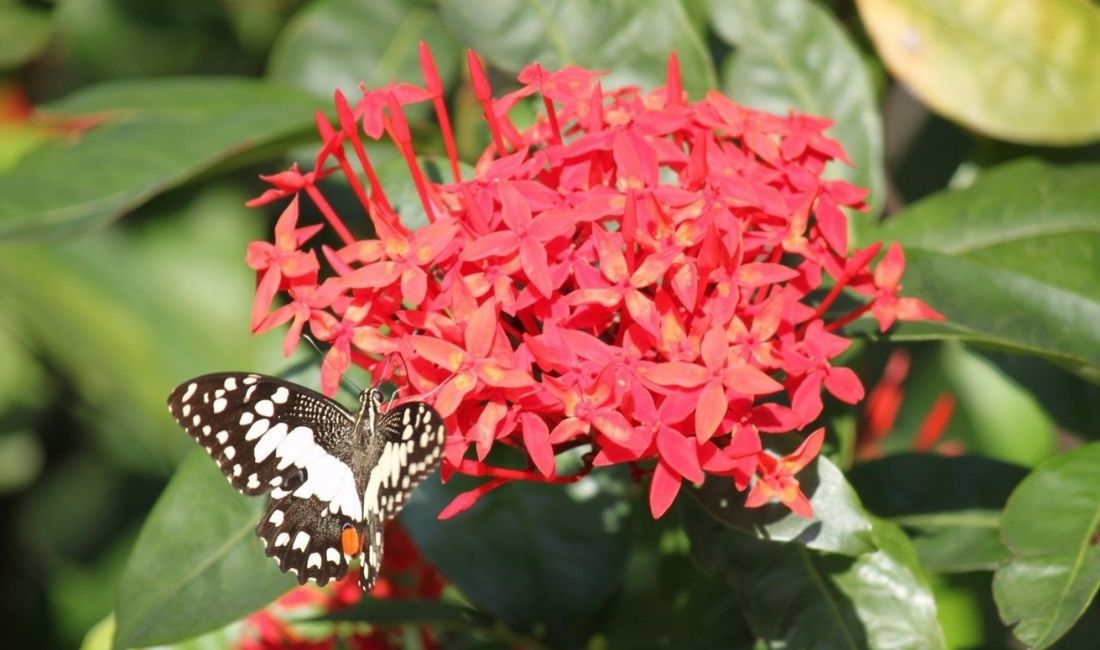
The genus Ixora contains over 500 species that range from evergreen trees to small shrubs. We’ll focus on the smaller, flowering shrubs of Ixora coccinea, commonly called “jungle geranium.”
Ixora originates in tropical climates, many from Asia, and are well adapted to South Florida’s climate.
Ixora coccinea cultivars are developed for their profuse, year-round flowering and brilliant colors. Their reliable, showy flowers are long-lasting, blooming for a month or more before fading.
Depending on the mature size of the Ixora cultivar you choose, these shrubs make ideal garden accent plants, screens, and flowering hedges.
Ixora bloom year-round and can be pruned or sheared. However, frequent pruning or shearing will reduce or prevent flowering; flower buds appear on new wood and those are removed by pruning or shearing. To minimize pruning and maximize flowering, choose an Ixora cultivar whose mature size fits its planting area.
- Recommended Uses: Container plant, accent plant, shrub, hedge, screen
- Size: 4’-12’ high and wide, depending on the cultivar
- Growth rate: Moderate to fast
- Hardiness: To 40 degrees F, expect some leaf damage below that
- Light Requirements: Needs full sun for best flowering
- Soil Type: Acidic soil preferred
- Tolerance: Saline water, moderate drought tolerance, no direct wind
- Foliage: Evergreen with 4” shiny, oval green leaves
- Foliage Texture: Coarse
- Flowers: Clusters of small, four-petaled flowers in white, pink, yellow, orange, or red, depending on the cultivar (see cultivar list below)
- Fruit: Small clusters of berries appear after flowering, turning red when ripe
- Diseases: Few, but check for aphids and scale
Recommended Ixora coccinea Cultivars
Below are some of the better cultivars that do well in Palm Beach landscapes, including details on the flower color and mature height.
- ‘Angela Busman’, rose-colored flowers, 3’-4’
- ‘Fraseri’, orange-rose flowers, 3’-5’
- ‘Prince of Orange’, orange flowers, 4’-6’
- ‘Maui’, orange flowers and greater cold tolerance, 2’-3’
- ‘Nora Grant’, red flowers, 3’
- ‘Super King’, large, dark red flowers, 3’-5’
- ‘Sunset’, yellow-orange flowers, 4’-6’
- ‘Singapore Yellow’, yellow flowers, 4’-6’
- ‘Frances Perry’, yellow flowers, 4’-6’
- ‘Herrera’s White’, white flowers, 4’-6’
Silver Buttonwood (Conocarpus erectus var. sericeus)
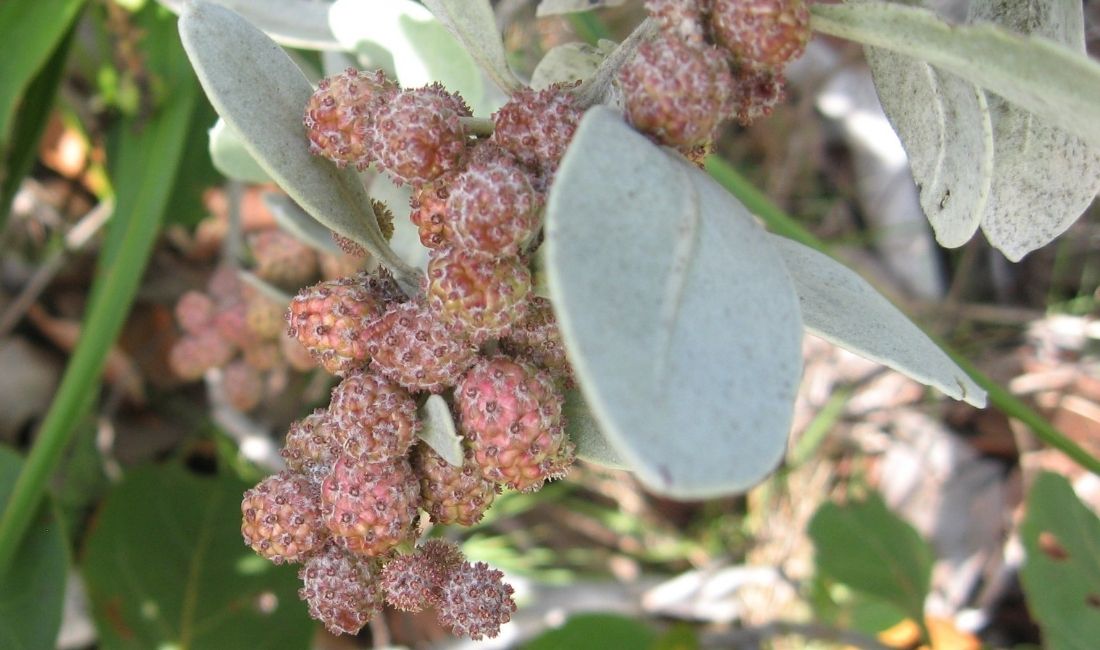
Silver Buttonwood is an evergreen tree that’s native to Florida, making it an ideal addition to your shoreline garden. Because it grows in brackish water and can endure flooding, it’s an excellent choice for landscapes near water.
Its silvery foliage is striking and makes an elegant contrast to other green-leafed plants and trees. We recommend using this shrubby tree as an accent plant or to provide screening. With regular pruning, you can grow it in a large container and keep it more compact. Pruning also helps to display its striking bark.
In bloom, Silver Buttonwood has small, inconspicuous white flowers, but those flowers become clusters of dark red, cone-shaped fruit that are showy against the silvery leaves.
- Recommended Uses: Container plant, screening hedge, specimen tree
- Size: 15’-40’ H x 20’-25’W, can be kept to below 10’ with pruning
- Shape: Multi trunk, spreading, vase shape. In windy areas, it develops a unique shape in response to prevailing wind patterns.
- Growth rate: Moderate
- Hardiness: To 10 degrees F
- Light Requirements: Full sun to part shade
- Soil Type: Tolerates clay, sand, wet, and a range of pH
- Tolerance: Wind, salt, urban conditions, drought
- Bark: Brown, scaly
- Branching: Often grown as a multi-trunk tree that remains at a lower height than the normal mature size
- Foliage: Evergreen foliage is silvery, bluish, with fine hairs, 2”-4” long oval
- Foliage Texture: Fine
- Flowers: Small, white, inconspicuous flowers. Blooms most of the year.
- Fruit: ½”, red-purple cone-shaped fruits
- Diseases: No real disease problems; check for sooty mold from sap-sucking insects
Green Island Ficus (Ficus microcarpa ‘Green Island’)
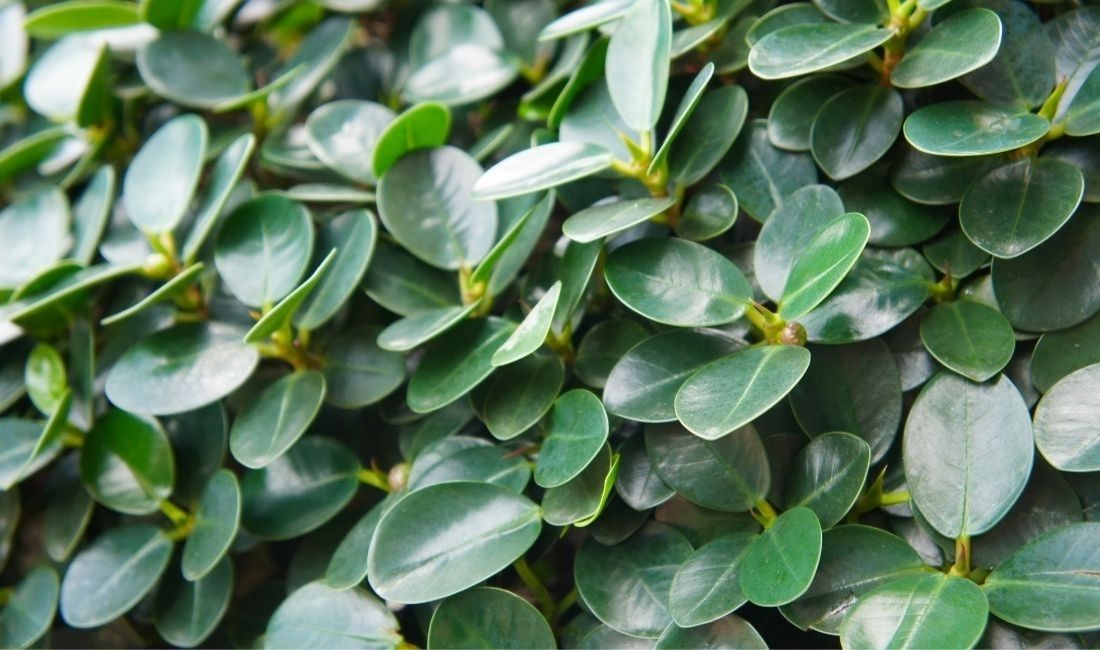
This compact, evergreen shrub has shiny, dark green leaves. While its leaves and branches resemble its parent plant Ficus macrocarpa, ‘Green Island’ is a cultivar that stays small and does not have invasive roots.
‘Green Island’ ficus is drought tolerant once established, and tolerant of coastal salt conditions. Its neat appearance and clean-looking, shiny leaves give structure and elegance to garden designs.
‘Green Island’ grows in sun and shade, making it a useful plant for a range of garden locations.
- Recommended Uses: Shrub, screening hedge, indoor plant
- Size: 8-10’ H x W, can easily be pruned to maintain a size around 3’
- Growth rate: Moderate
- Hardiness: Frost tender, will sustain leaf damage when temperatures approach freezing
- Light requirements: Sun to shade
- Soil type: Adaptable to a range of soils; avoid poorly draining clay soils
- Foliage Texture: Fine, with dense foliage
- Tolerances: Salt, wind, drought tolerant
- Care: Prune to keep at a lower design height; otherwise, only occasional pruning is needed. Can be clipped or sheared
- Diseases: Few serious disease problems but check for scale and mealybugs
Mimusops (Mimusops elengi )
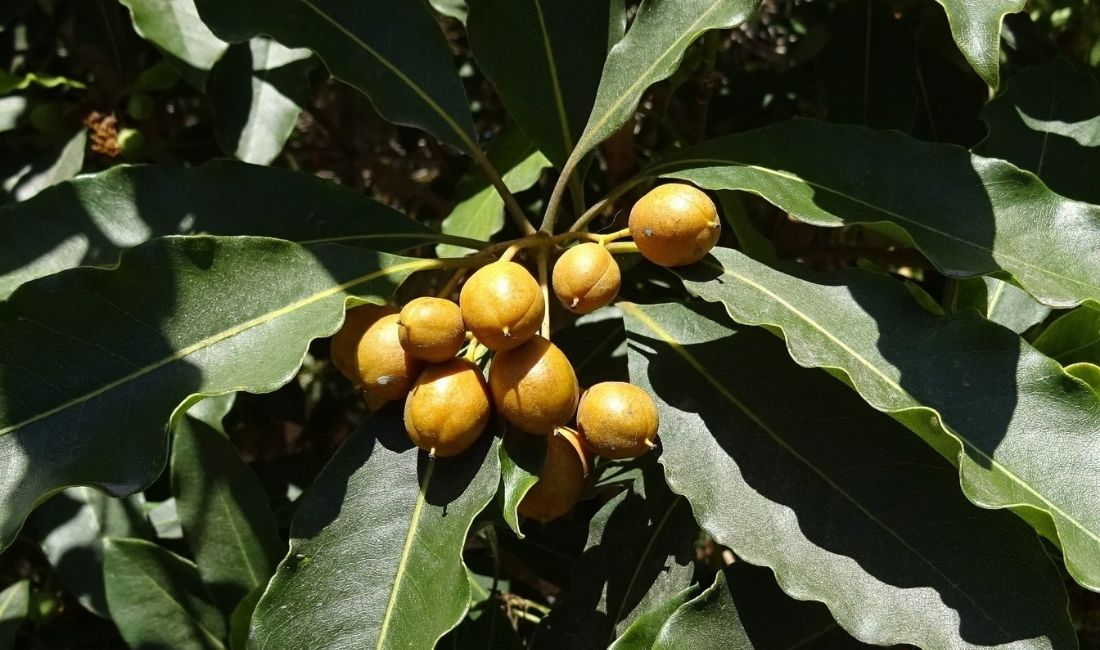
Mimusops is an evergreen tree native to Southeast Asia and northern Australia that is adapted to South Florida’s coastal conditions. Mimusops has several common names, including “Spanish cherry.” Another common name is “medlar”, but this tree is not the true medlar.
This tree is traditionally grown for its strongly scented flowers, which are used in perfumery and tea, as well as for its edible fruit. The tree’s bark is used in Ayurvedic medicine to treat fever, dysentery, and dental pain, and its seeds are pressed for oil.
The tree’s combination of striking bark, smooth, wavy leaves, and fragrant flowers make it an ideal ornamental screening tree. Because of its substantial height at maturity, it can also be used to provide shade.
Mimusops is adaptable, growing in both humid locations with regular rainfall and seasonally dry areas. Its tolerance to wind and salt makes it an ideal coastal tree for Palm Beach landscapes.
- Recommended Uses: Screening tree, shade tree
- Size: 50’-90’ H x 20’-35’ W
- Growth rate: Moderate
- Hardiness: Considered frost tender but can endure brief, light frosts
- Light: Full sun
- Soil type: Prefers rich, loamy soil but is relatively well adapted to sandy and saline soils
- Tolerance: Wind, salt spray
- Bark: Dark brown, with vertical fissures
- Branching: Often a multi-trunk tree that remains at a lower height than mature size.
- Foliage: Evergreen with dark green, shiny, oval leaves that are 4-6” long with wavy margins
- Foliage Texture: Moderately coarse
- Flowers: Clusters of 1” wide, star-shaped white flowers, very fragrant, blooms year-round
- Fruit: Small, edible fruits are oval, will turn orange-red when ripe.
Garcinia (Garcinia spicata)
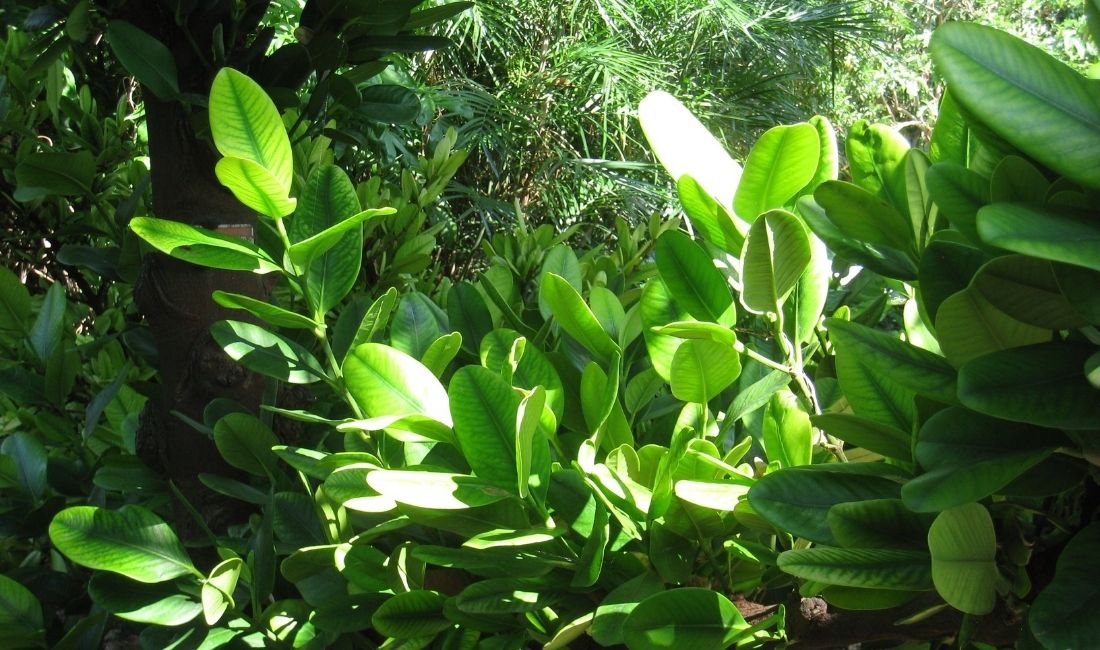
This evergreen tree is prized for its thick green foliage and dense, upright shape. It’s a useful tree for screens and hedges. Garcinia’s shiny leaves are held upright on branches and beautifully set off its round, yellow-orange fruits.
Garcinia is closely related to the mangosteen (G. mangostana) but its fruits are bitter and mainly eaten by birds. “Garlic fruit” is a common name for them, which gives you an idea of their odor!
- Recommended Uses: Screening tree, hedge
- Size: 15’-30’ H x 10’-20’W, often smaller because of slow growth rate
- Shape: Oval, upright
- Growth rate: Slow
- Hardiness: Frost tender
- Light: Full sun to filtered shade
- Soil type: Moist, acid soil preferred, although it will grow in neutral pH soil
- Tolerance: Wind, salt
- Bark: Brown to gray, can be smooth or mottled
- Branching: Upright branches, spreading with age
- Foliage: Shiny evergreen leaves that are oval, upright, and slightly cupped. Leaves are bronze when young, turning a clear green as they mature.
- Foliage Texture: Coarse
- Flowers: Small, greenish-white, appearing in clusters along the branch stem
- Fruit: 2”-4”, globe-shaped fruit with a pointed end and smooth, yellow-orange skin
- Diseases: No real disease problems; check for sooty mold from sap-sucking insects
>> You can also check out the best palms for your Palm Beach property here.
Need a Hand?
Whether you’d like help selecting the best plants for your Palm Beach landscape or want to ensure your new tree or shrub is properly planted, the Coastal Garden professionals will take care of it. We grow a large selection of plants at our nursery right here on the island so you know they’ll be hardy and well adapted to our climate. With landscape designers and horticulturists on staff, we have the experience to recommend the right plants for your needs as well as the skills to install all plant material to the highest standards.
CALL US TODAY At 561-308-7604
Estate landscape Services
For Fine Properties in Palm Beach
With Coastal Gardens, you can rest easy knowing that your property is taken care of by a dedicated team of estate landscape professionals who truly care about creating and maintaining a dazzling outdoor space you can be proud of.
